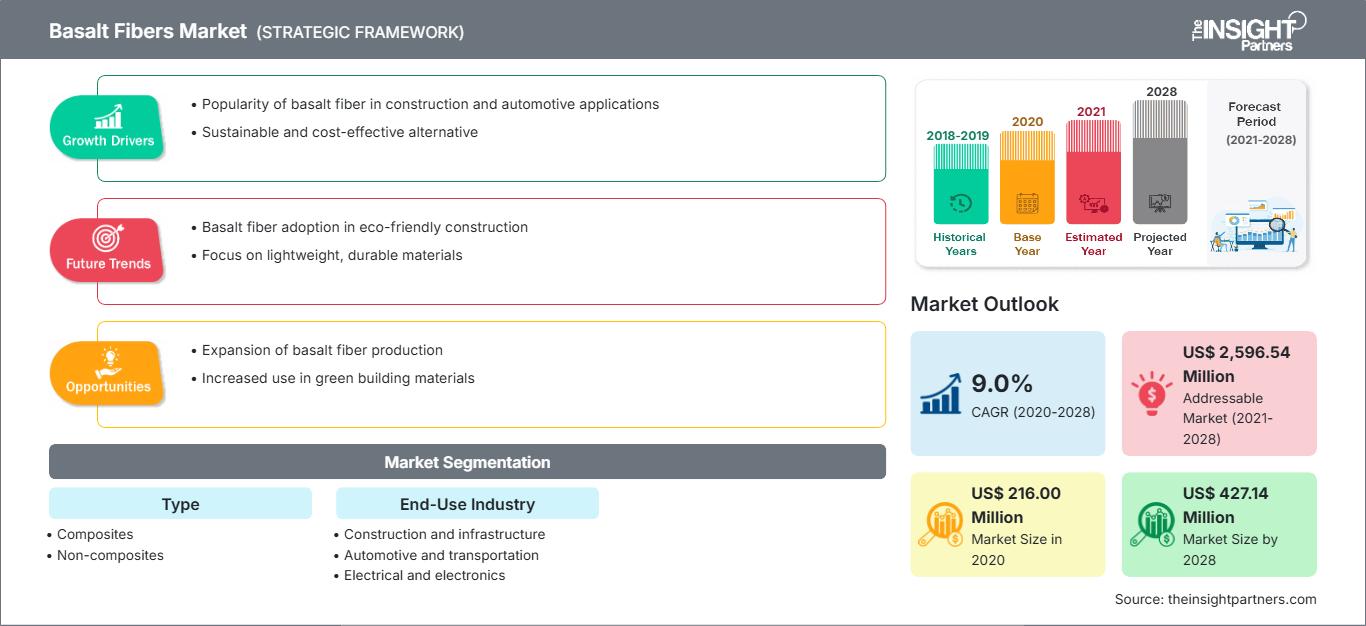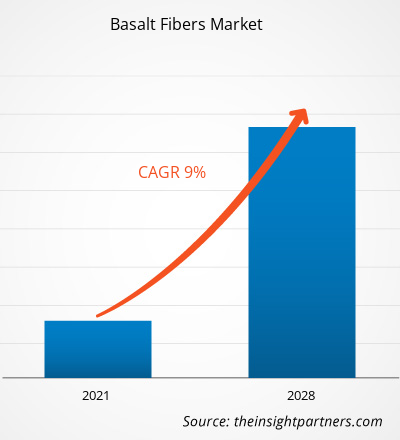Il mercato delle fibre di basalto è stato valutato a 216,00 milioni di dollari nel 2020 e si prevede che raggiungerà i 427,14 milioni di dollari entro il 2028; si prevede che registrerà un CAGR del 9,0% dal 2021 al 2028.
Le fibre di basalto possiedono proprietà chimiche simili alle fibre di vetro, ma hanno proprietà fisico-chimiche migliori. Si prevede che il mercato delle fibre di basalto registrerà una forte crescita grazie alla domanda da parte di settori di utilizzo finale come l'automotive, la nautica, l'edilizia e l'elettronica. L'aumento delle attività di costruzione in diverse regioni, dovuto alla crescita demografica, all'aumento del reddito e alle iniziative governative in diverse economie per sviluppare infrastrutture migliori, probabilmente stimolerà la crescita del mercato delle fibre di basalto. Tuttavia, le proprietà incoerenti delle materie prime sono tra i fattori che frenano la crescita del mercato delle fibre di basalto.
Nel 2020, l'Asia-Pacifico ha rappresentato la quota maggiore del mercato globale delle fibre di basalto. Il continente Asia-Pacifico comprende diverse economie in via di sviluppo e sviluppate come India, Cina, Giappone, Corea del Sud e Australia. I paesi emergenti stanno assistendo a un'impennata delle attività di industrializzazione e urbanizzazione. Si prevede che la crescita dei progetti di costruzione in paesi come India e Cina e i crescenti investimenti in attività infrastrutturali, come la costruzione di nuove autostrade, ferrovie, linee metropolitane sotterranee e rivestimenti stradali, rafforzeranno il mercato delle fibre di basalto nella regione.
Personalizza questo rapporto in base alle tue esigenze
Potrai personalizzare gratuitamente qualsiasi rapporto, comprese parti di questo rapporto, o analisi a livello di paese, pacchetto dati Excel, oltre a usufruire di grandi offerte e sconti per start-up e università
Mercato delle fibre di basalto: Approfondimenti strategici

- Ottieni le principali tendenze chiave del mercato di questo rapporto.Questo campione GRATUITO includerà l'analisi dei dati, che vanno dalle tendenze di mercato alle stime e alle previsioni.
Potrai personalizzare gratuitamente qualsiasi rapporto, comprese parti di questo rapporto, o analisi a livello di paese, pacchetto dati Excel, oltre a usufruire di grandi offerte e sconti per start-up e università
Mercato delle fibre di basalto: Approfondimenti strategici

- Ottieni le principali tendenze chiave del mercato di questo rapporto.Questo campione GRATUITO includerà l'analisi dei dati, che vanno dalle tendenze di mercato alle stime e alle previsioni.
Impatto della pandemia di COVID-19 sul mercato delle fibre di basalto
La pandemia in corso ha drasticamente alterato lo stato del settore chimico e dei materiali e ha avuto un impatto negativo sulla crescita del mercato delle fibre di basalto.
L'attuazione di misure per contrastare la diffusione del virus ha avuto un impatto sulla crescita di diversi settori industriali. Settori come l'edilizia, l'automotive, la chimica e l'elettronica hanno subito l'impatto dell'improvvisa distorsione dell'efficienza operativa e delle interruzioni nelle catene del valore attribuibili alla chiusura improvvisa dei confini nazionali e internazionali. Il significativo calo della crescita di diversi settori industriali ha avuto un impatto significativo sulla domanda di fibre di basalto nel mercato globale. Tuttavia, poiché le economie stanno pianificando di riprendere le proprie attività, si prevede che la domanda di fibre di basalto aumenterà a livello globale. Si prevede che la crescente domanda di fibre di basalto in vari settori come l'edilizia, l'automotive, la chimica, l'elettronica e l'aerospaziale, insieme ai significativi investimenti da parte di importanti produttori, guiderà la crescita delle fibre di basalto.
Approfondimenti di mercato: ampie applicazioni delle fibre di basalto in vari settori finali per guidare la crescita del mercato
Le fibre di basalto hanno un ampio spettro di applicazioni in vari settori finali, come l'edilizia, l'automotive, l'elettrico e l'elettronica, la chimica, l'aerospaziale e la nautica. Nell'edilizia, i fili di basalto tritati vengono utilizzati per aumentare la resistenza alla fessurazione dei pannelli di cemento. Grazie alla loro esclusiva stabilità chimica in condizioni estreme, le fibre di basalto possono essere utilizzate in molte strutture in calcestruzzo, come ponti, gallerie, dighe e solai. Le fibre di basalto sono utilizzate nell'industria chimica per la produzione di tubi resistenti agli agenti chimici, rivestimenti protettivi, serbatoi di stoccaggio per liquidi corrosivi, fertilizzanti chimici, acidi, sostanze tossiche, ecc. Con l'approfondimento dell'applicazione delle fibre di basalto, la domanda di mercato per questo tipo di fibra sta aumentando a un ritmo più rapido.Approfondimenti sui prodotti
In base al prodotto, il mercato globale delle fibre di basalto è segmentato in roving, filati tagliati, filati ritorti, tessuti e nastri e altri. Il segmento del roving ha detenuto la quota maggiore nel mercato globale delle fibre di basalto nel 2020. Il roving di basalto è un fascio di fibre di basalto complesse unidirezionali continue. Il roving presenta resistenza agli ambienti aggressivi, elevata resistenza naturale, lunga durata e proprietà di isolamento elettrico superiori. In base alle sue caratteristiche tecniche, il roving di basalto supera il vetro E e il vetro S sotto numerosi aspetti. Il roving di basalto è estremamente resistente al calore e può resistere a temperature fino a 1.000 °C per un breve periodo.
Kamenny Vek Company; Fiberbas Construction and Building Technologies; Hydro Design Management Co. Pvt. Ltd.; Hg Gbf Basalt Fiber Co., Ltd; Bastech; Mafic SA; Shanxi Basalt Fiber Technology Co. Ltd; Technobasalt-Invest LLC; Deutsche Basalt Faser Gmbh; e Basalt Engineering LLC sono tra i principali attori chiave che operano nel mercato globale della fibra di basalto.
In evidenza nel rapporto
- Tendenze progressive del settore nel mercato della fibra di basalto per aiutare gli operatori a sviluppare strategie efficaci a lungo termine
- Strategie di crescita aziendale adottate dai mercati sviluppati e in via di sviluppo
- Analisi quantitativa del mercato della fibra di basalto dal 2019 al 2028
- Stima della domanda globale di fibra di basalto
- Analisi PEST per illustrare l'efficacia di acquirenti e fornitori che operano nel settore
- Sviluppi recenti per comprendere lo scenario competitivo del mercato
- Tendenze e prospettive di mercato, nonché fattori che guidano e frenano la crescita del mercato della fibra di basalto
- Assistenza nel processo decisionale evidenziando le strategie di mercato che sostengono l'interesse commerciale, portando alla crescita del mercato
- Le dimensioni del mercato della fibra di basalto in vari nodi
- Panoramica dettagliata e segmentazione del mercato, nonché dinamiche del settore delle fibre di basalto
- Dimensioni del mercato delle fibre di basalto in varie regioni con promettenti opportunità di crescita
Approfondimenti regionali sul mercato delle fibre di basalto
Le tendenze regionali e i fattori che influenzano il mercato delle fibre di basalto durante il periodo di previsione sono stati ampiamente spiegati dagli analisti di The Insight Partners. Questa sezione illustra anche i segmenti e la distribuzione geografica del mercato delle fibre di basalto in Nord America, Europa, Asia-Pacifico, Medio Oriente e Africa, America meridionale e centrale.
Ambito del rapporto di mercato sulle fibre di basalto
| Attributo del rapporto | Dettagli |
|---|---|
| Dimensioni del mercato in 2020 | US$ 216.00 Million |
| Dimensioni del mercato per 2028 | US$ 427.14 Million |
| CAGR globale (2020 - 2028) | 9.0% |
| Dati storici | 2018-2019 |
| Periodo di previsione | 2021-2028 |
| Segmenti coperti |
By Tipo
|
| Regioni e paesi coperti | Nord America
|
| Leader di mercato e profili aziendali chiave |
|
Densità degli attori del mercato delle fibre di basalto: comprendere il suo impatto sulle dinamiche aziendali
Il mercato delle fibre di basalto è in rapida crescita, trainato dalla crescente domanda degli utenti finali, dovuta a fattori quali l'evoluzione delle preferenze dei consumatori, i progressi tecnologici e una maggiore consapevolezza dei benefici del prodotto. Con l'aumento della domanda, le aziende stanno ampliando la propria offerta, innovando per soddisfare le esigenze dei consumatori e sfruttando le tendenze emergenti, alimentando ulteriormente la crescita del mercato.

- Ottieni il Mercato delle fibre di basalto Panoramica dei principali attori chiave
Mercato globale della fibra di basalto
Per prodotto
- Roving
- Chopped Strand
- Filati ritorti
- Tessuti e nastri
- Altro
Per uso finale Industria
- Edilizia
- Automotive
- Elettricità ed elettronica
- Chimica
- Altro
Profili aziendali
- Società Kamenny Vek
- Fiberbas Construction and Building Technologies
- Hydro Design Management Co. Pvt. Ltd.
- Hg Gbf Basalt Fiber Co., Ltd
- Bastech
- Mafic SA
- Shanxi Basalt Fiber Technology Co. Ltd
- Technobasalt-Invest LLC
- Deutsche Basalt Faser Gmbh
- Basalt Engineering LLC
- Analisi storica (2 anni), anno base, previsione (7 anni) con CAGR
- Analisi PEST e SWOT
- Valore/volume delle dimensioni del mercato - Globale, Regionale, Nazionale
- Industria e panorama competitivo
- Set di dati Excel
Report recenti
Rapporti correlati
Testimonianze
Motivo dell'acquisto
- Processo decisionale informato
- Comprensione delle dinamiche di mercato
- Analisi competitiva
- Analisi dei clienti
- Previsioni di mercato
- Mitigazione del rischio
- Pianificazione strategica
- Giustificazione degli investimenti
- Identificazione dei mercati emergenti
- Miglioramento delle strategie di marketing
- Aumento dell'efficienza operativa
- Allineamento alle tendenze normative






















 Ottieni un campione gratuito per - Mercato delle fibre di basalto
Ottieni un campione gratuito per - Mercato delle fibre di basalto